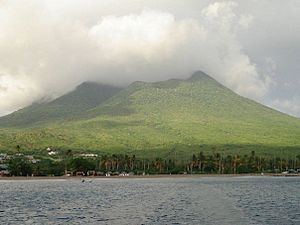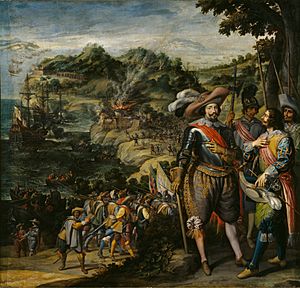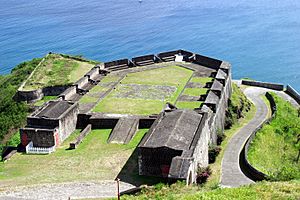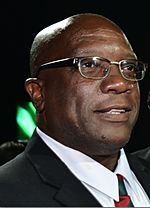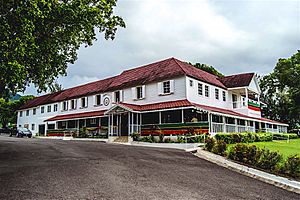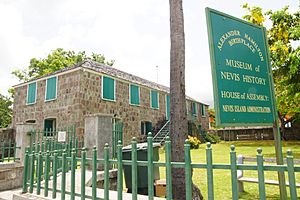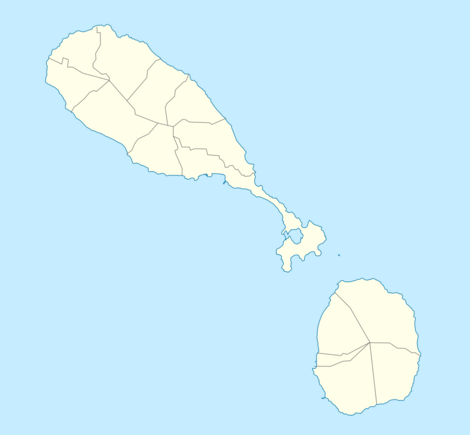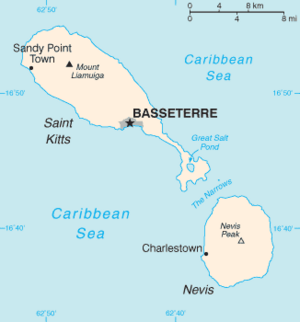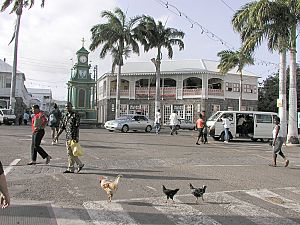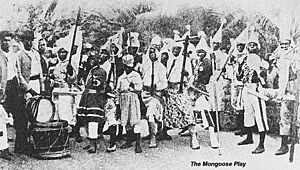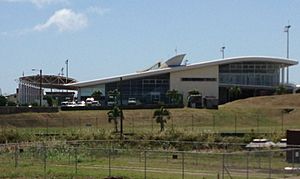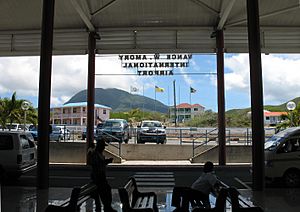Saint Kitts and Nevis facts for kids
Quick facts for kids
Federation of Saint Christopher and Nevis
|
|
|---|---|
|
|
|
|
Motto: "Country Above Self"
|
|
|
Anthem: "O Land of Beauty!"
|
|
 |
|
| Capital and largest city
|
Basseterre 17°18′N 62°44′W / 17.300°N 62.733°W |
| Official languages | English |
| Vernacular language | Saint Kitts Creole |
| Ethnic groups
(2020)
|
|
| Religion
(2020)
|
|
| Demonym(s) |
|
| Government | Federal parliamentary constitutional monarchy |
|
• Monarch
|
Charles III |
| Marcella Liburd | |
| Terrance Drew | |
| Legislature | National Assembly |
| Independence
from the United Kingdom
|
|
|
• Associated State
|
27 February 1967 |
|
• Independence declared
|
19 September 1983 |
| Area | |
|
• Total
|
261 km2 (101 sq mi) (188th) |
|
• Water (%)
|
Negligible |
| Population | |
|
• 2018 estimate
|
52,441 (187th) |
|
• 2023 census
|
54,338 |
|
• Density
|
164/km2 (424.8/sq mi) (64th) |
| GDP (PPP) | 2023 estimate |
|
• Total
|
|
|
• Per capita
|
|
| GDP (nominal) | estimate |
|
• Total
|
|
|
• Per capita
|
|
| HDI (2022) | very high · 51st |
| Currency | East Caribbean dollar (EC$) (XCD) |
| Time zone | UTC-4 (AST) |
| Driving side | left |
| Calling code | +1 869 |
| ISO 3166 code | KN |
| Internet TLD | .kn |
|
|
Saint Kitts and Nevis, officially the Federation of Saint Christopher and Nevis, is a small island country. It is made up of two islands, Saint Kitts and Nevis. These islands are located in the West Indies, part of the Lesser Antilles.
With an area of 261 square kilometers (104 square miles) and about 48,000 people, it is the smallest independent country in the Western Hemisphere. This is true for both its size and its population. It is also the world's smallest independent federation. The country is a Commonwealth realm, which means Charles III is its King and head of state.
The capital city is Basseterre, found on the larger island of Saint Kitts. Basseterre is also the main port for ships, including cruise ships and cargo vessels. The smaller island of Nevis is about 3 kilometers (2 miles) southeast of Saint Kitts. A shallow channel called The Narrows separates them.
Historically, the British territory of Anguilla was also part of this group. It was known as Saint Christopher-Nevis-Anguilla. However, Anguilla decided to leave the union in 1967. It is still a British overseas territory today.
Saint Kitts and Nevis were among the first Caribbean islands settled by Europeans. Saint Kitts was home to the first British and French colonies in the Caribbean. Because of this, it is sometimes called "The Mother Colony of the West Indies." It gained independence from Britain in 1983, making it the most recent British territory in the Caribbean to do so.
Contents
What's in a Name?
The first people on Saint Kitts were the Kalinago. They called the island Liamuiga, which means 'fertile land'.
It is believed that Christopher Columbus saw the islands in 1493. He might have named the larger island San Cristóbal after Saint Christopher. Saint Christopher is his patron saint and the saint of travelers. Some newer studies suggest Columbus named it Sant Yago (meaning Saint James). They think the name San Cristóbal was given to the island now called Saba. By the 17th century, Saint Kitts was known as San Cristóbal. The first English settlers used the English version, calling it St. Christopher's Island. Later, people started calling Christopher "Kit." So, the island became known as Saint Kitt's Island, and then Saint Kitts.
Columbus named Nevis San Martín (after Saint Martin). The name Nevis comes from a Spanish name, Nuestra Señora de las Nieves. This means "Our Lady of the Snows." This name refers to a Catholic story from the 4th century about snow falling in Rome during summer. It's thought that the white clouds often seen around the top of Nevis Peak reminded someone of this story.
Today, the country's Constitution uses both Saint Kitts and Nevis and Saint Christopher and Nevis. Saint Kitts and Nevis is used more often. However, Saint Christopher and Nevis is generally used for official diplomatic matters. Passports for citizens say St. Kitts and Nevis.
A Look Back: History of the Islands
Early People and European Arrival
The first people to live on these islands were Pre-Arawakan peoples. They arrived perhaps 3,000 years ago. Later, the Arawak peoples, or Taíno, came around 1000 BC. The Island Caribs arrived around 800 AD.
Christopher Columbus was the first European to see the islands in 1493. The first English settlers arrived in 1623. They were led by Thomas Warner. They started a settlement at Old Road Town on Saint Kitts. The French also settled on Saint Kitts in 1625. The English and French then divided the island into their own areas. From 1628, the English also began settling on Nevis.
The native Caribs resisted the European settlers. In 1626, the English and French settlers worked together. They had a major conflict with the Caribs at a place called Bloody Point. After this, the Europeans started large sugar plantations. They brought many African slaves to work on these plantations. This made the plantation owners rich. It also changed the population of the islands, as enslaved people soon outnumbered Europeans.
In 1629, a Spanish group came and destroyed the English and French settlements. They sent the settlers back to their home countries. But in 1630, Spain allowed the English and French colonies to be rebuilt. Spain later officially recognized Britain's claim to Saint Kitts in 1670.
British Rule and Changes
As Spain's power lessened, Saint Kitts became an important base for England and France in the Caribbean. From Saint Kitts, the British settled other islands like Antigua and Montserrat. The French settled islands like Martinique and Guadeloupe. In the late 1600s, France and England fought over Saint Kitts and Nevis. France gave up its claim to the islands in 1713.
By the 1700s, Saint Kitts became very rich due to its sugar industry, which relied on enslaved labor. Nevis, which was once richer, became less important economically. Alexander Hamilton, who later became a famous U.S. leader, was born on Nevis in 1755 or 1757.
During the American Revolutionary War, the French tried to take Saint Kitts in 1782. However, Saint Kitts was returned to Britain in 1783.
The trade of African slaves was stopped in the British Empire in 1807. Slavery itself was completely outlawed in 1834. After this, enslaved people worked for their former owners for four years, earning wages. On Nevis, 8,815 enslaved people were freed. On Saint Kitts, 19,780 were freed.
Saint Kitts and Nevis, along with Anguilla, joined together in 1882. In the early 1900s, people faced economic difficulties. This led to the growth of groups fighting for workers' rights. Sugar workers went on strike in 1935. The Saint Kitts and Nevis Labour Party was formed in the 1940s. Its leader, Robert Llewellyn Bradshaw, later became the Premier. He worked to give the government more control over the sugar industry.
After being part of the West Indies Federation for a short time (1958–62), the islands became an associated state in 1967. This meant they had full control over their internal affairs. People in Nevis and Anguilla were not happy with Saint Kitts having too much power. Anguilla declared independence in 1967. Britain took back control of Anguilla in 1971, and it officially separated in 1980.
Then, attention turned to Nevis. The Nevis Reformation Party wanted to protect Nevis's interests in any future independent country. It was agreed that Nevis would have some self-rule. It would have its own Premier and Assembly. It also had the right to leave the federation if two-thirds of its voters agreed in a special vote.
Independence and Today
Saint Kitts and Nevis became fully independent on September 19, 1983. Kennedy Simmonds became the country's first Prime Minister. Saint Kitts and Nevis decided to remain part of the British Commonwealth. This meant Queen Elizabeth was still their Queen, represented by a Governor-General.
In Nevis, some people still wanted to separate from Saint Kitts. In 1998, a vote to separate was held. 62% voted to leave, but this was not enough for the two-thirds majority needed.
The sugar industry, which had been declining for years, was completely closed in 2005. In 2012, the World Health Organization declared Saint Kitts and Nevis free of malaria.
In 2015, Timothy Harris became Prime Minister. He led the People's Labour Party with support from other groups.
How the Government Works
Saint Kitts and Nevis is a free, democratic, and federal country. It is a Commonwealth realm, which means Charles III is its head of state. The King is represented by a Governor-General. The Governor-General acts on the advice of the Prime Minister and the Cabinet. The Prime Minister is the leader of the party with the most seats in the National Assembly. The Cabinet handles the country's affairs.
Saint Kitts and Nevis has one main law-making body called the National Assembly. It has fourteen members. Eleven members are elected by the people (three from Nevis). Three senators are chosen by the Governor-General. Two senators are chosen based on the Prime Minister's advice. One senator is chosen based on the advice of the opposition leader. All members serve for five years. The Prime Minister and Cabinet report to the Parliament. Nevis also has its own assembly with some self-rule.
Parts of the Country
Saint Kitts and Nevis is divided into fourteen areas called parishes. Nine of these parishes are on Saint Kitts, and five are on Nevis.
|
| Parishes | Capital | Population 2011 |
Area (km2) |
Population density per km2 |
Island |
|---|---|---|---|---|---|
| Christ Church Nichola Town | Nichola Town | 1,922 | 18 | 107 | Saint Kitts |
| Saint Anne Sandy Point | Sandy Point Town | 2,626 | 13 | 202 | Saint Kitts |
| Saint George Basseterre | Basseterre | 12,635 | 29 | 436 | Saint Kitts |
| Saint John Capisterre | Dieppe Bay Town | 2,962 | 25 | 118 | Saint Kitts |
| Saint Mary Cayon | Cayon | 3,435 | 15 | 229 | Saint Kitts |
| Saint Paul Capisterre | Saint Paul Capisterre | 2,432 | 14 | 174 | Saint Kitts |
| Saint Peter Basseterre | Monkey Hill | 4,670 | 21 | 222 | Saint Kitts |
| Saint Thomas Middle Island | Middle Island | 2,535 | 25 | 101.4 | Saint Kitts |
| Trinity Palmetto Point | Trinity | 1,701 | 16 | 106 | Saint Kitts |
| Saint George Gingerland | Market Shop | 2,496 | 18 | 139 | Nevis |
| Saint James Windward | Newcastle | 2,038 | 32 | 64 | Nevis |
| Saint John Figtree | Figtree | 3,827 | 22 | 174 | Nevis |
| Saint Paul Charlestown | Charlestown | 1,847 | 4 | 462 | Nevis |
| Saint Thomas Lowland | Cotton Ground | 2,069 | 18 | 115 | Nevis |
Exploring the Geography
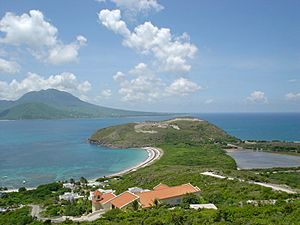
The capital city is Basseterre, located on the larger island of Saint Kitts. Basseterre is also the main port for ships and cargo. The smaller island of Nevis is about 3 kilometers (2 miles) to the southeast of Saint Kitts. They are separated by a shallow channel called The Narrows.
Other nearby islands include Sint Eustatius, Saba, Saint Barthélemy, Saint-Martin/Sint Maarten, and Anguilla to the north. To the east are Antigua and Barbuda, and to the southeast is Montserrat.
Both Saint Kitts and Nevis were formed by volcanic activity. They have large central peaks covered in tropical rainforest. Most people live along the flatter coastal areas. Saint Kitts has several mountain ranges in its center. The highest peak in the country, Mount Liamuiga, is 1,156 meters (3,793 feet) tall. On the east coast are the Canada Hills and Conaree Hills. The land gets much narrower in the southeast, forming a flatter area with the largest body of water, the Great Salt Pond. A small island called Booby Island is in The Narrows. Many rivers flow from the mountains, providing fresh water. Nevis, the smaller island, is mostly round. It is dominated by Nevis Peak, which is 985 meters (3,232 feet) tall.
Plants and Animals
The national bird of Saint Kitts and Nevis is the brown pelican. There are 176 different kinds of birds reported in the country.
The national flower is Delonix regia. Common plants include palmetto, hibiscus, bougainvillea, and tamarind. Pinus trees are common in the dense forests. They are often covered by different types of ferns.
What's the Climate Like?
Saint Kitts has a tropical savanna climate. Nevis has a tropical monsoon climate. This means they are warm all year round. In Basseterre, the average monthly temperatures stay between 23.9°C (75°F) and 26.6°C (80°F). The country gets about 2,400 millimeters (94 inches) of rain each year.
| Climate data for Saint Kitts and Nevis (1991–2015) | |||||||||||||
|---|---|---|---|---|---|---|---|---|---|---|---|---|---|
| Month | Jan | Feb | Mar | Apr | May | Jun | Jul | Aug | Sep | Oct | Nov | Dec | Year |
| Daily mean °C (°F) | 23.9 (75.0) |
23.8 (74.8) |
24.0 (75.2) |
24.7 (76.5) |
25.5 (77.9) |
26.2 (79.2) |
26.3 (79.3) |
26.6 (79.9) |
26.4 (79.5) |
26.0 (78.8) |
25.4 (77.7) |
24.4 (75.9) |
25.3 (77.5) |
| Average precipitation mm (inches) | 150 (5.9) |
102 (4.0) |
99 (3.9) |
153 (6.0) |
219 (8.6) |
181 (7.1) |
214 (8.4) |
232 (9.1) |
222 (8.7) |
289 (11.4) |
286 (11.3) |
225 (8.9) |
2,372 (93.3) |
| Source: Climate Change Knowledge Portal | |||||||||||||
People and Culture
Population and Background
The population of Saint Kitts and Nevis is about 53,000 people. It has stayed about the same for many years. About three-quarters of the people live on Saint Kitts. Around 15,500 of them live in the capital, Basseterre. Other large towns include Cayon (3,000 people) and Sandy Point Town (3,000) on Saint Kitts. On Nevis, Gingerland (2,500) and Charlestown (1,900) are important towns.
Most of the people (92.5%) are of African background. There are also smaller groups of European (2.1%) and Indian (1.5%) descent.
Languages Spoken
English is the only official language. However, Saint Kitts Creole is also spoken by many people.
Beliefs and Religions
Religion in Saint Kitts and Nevis (2011) Christianity (87.6%) No religion (atheism, agnosticism, etc) (8.6%) Hinduism (1.15%) Rasta (1.2%) Muslim (1.89%) Other (5.6%)
Most people (82%) are Christians. Many are Anglican, Methodist, or other Protestant groups. Roman Catholics also have churches there.
Hinduism is the largest non-Christian religion. It is followed by 1.82% of the people, mainly those of Indian descent.
Music and Fun Festivals
Saint Kitts and Nevis is known for its many music celebrations. These include Carnival (December 18 to January 3 on Saint Kitts). The St Kitts Music Festival happens in the last week of June. The week-long Culturama on Nevis is from late July to early August.
Other festivals on Saint Kitts include Inner City Fest in February and Green Valley Festival around Whit Monday. Easterama is around Easter, and Fest-Tab is in July or August. La festival de Capisterre is around Independence Day (September 19). These events often have parades, street dances, and music like salsa, jazz, soca, calypso, and steelpan music.
Sports and Athletes
Cricket is very popular in Saint Kitts and Nevis. Top players can join the West Indies cricket team. The 2007 Cricket World Cup even had matches played at the Warner Park Stadium in Saint Kitts. This made Saint Kitts and Nevis the smallest country to host World Cup matches.
Rugby and netball are also common sports.
The St. Kitts and Nevis national football team, called the "Sugar Boyz," has had some success. They reached the semi-final round for the 2006 FIFA World Cup. They also qualified for the 2023 CONCACAF Gold Cup, which was a big achievement. Atiba Harris is a famous footballer from the country.
Kim Collins is the country's most famous track and field athlete. He won gold medals in the 100 metres at the World Championships and Commonwealth Games. He was the first athlete from the country to reach an Olympic final at the 2000 Sydney Olympics. In 2011, the four by one hundred meter relay team won a bronze medal at the world championships.
How the Economy Works

Saint Kitts and Nevis has an economy based on tourism, farming, and light manufacturing. Sugar used to be the main export. But because it cost more to produce and world prices were low, the government decided to grow other crops. In 2005, the government closed the state-owned sugar company.
The country relies a lot on tourism. This industry has grown a lot since the 1970s. In recent years, the government has tried to make the economy more diverse. They are focusing on tourism, farming, making goods for export, and offshore banking.
Getting Around
Saint Kitts and Nevis has two international airports. The larger one is Robert L. Bradshaw International Airport on Saint Kitts. It has flights to the Caribbean, North America, and Europe. The other airport, Vance W. Amory International Airport, is on Nevis. It has flights to other parts of the Caribbean.
The St. Kitts Scenic Railway is the last working railroad in the Lesser Antilles.
Citizenship by Investment
Saint Kitts and Nevis has a special program called Citizenship-by-Investment. This allows people from other countries to become citizens if they make a large investment in the country. This program started in 1984 and is the oldest of its kind.
To become a citizen through this program, applicants must go through a careful check. They also need to make a minimum investment. This can be by buying approved real estate or by donating money to the government's fund or an approved public charity. If approved, they can get a Saint Kitts and Nevis passport.
Learning and Education
There are eight public high schools in Saint Kitts and Nevis. There are also several private secondary schools. Education is required for children between the ages of 5 and 16.
Related Pages
- List of rivers of Saint Kitts and Nevis
- Saint Kitts and Nevis at the Olympics
- Saint Kitts and Nevis national football team
See also
 In Spanish: San Cristóbal y Nieves para niños
In Spanish: San Cristóbal y Nieves para niños




